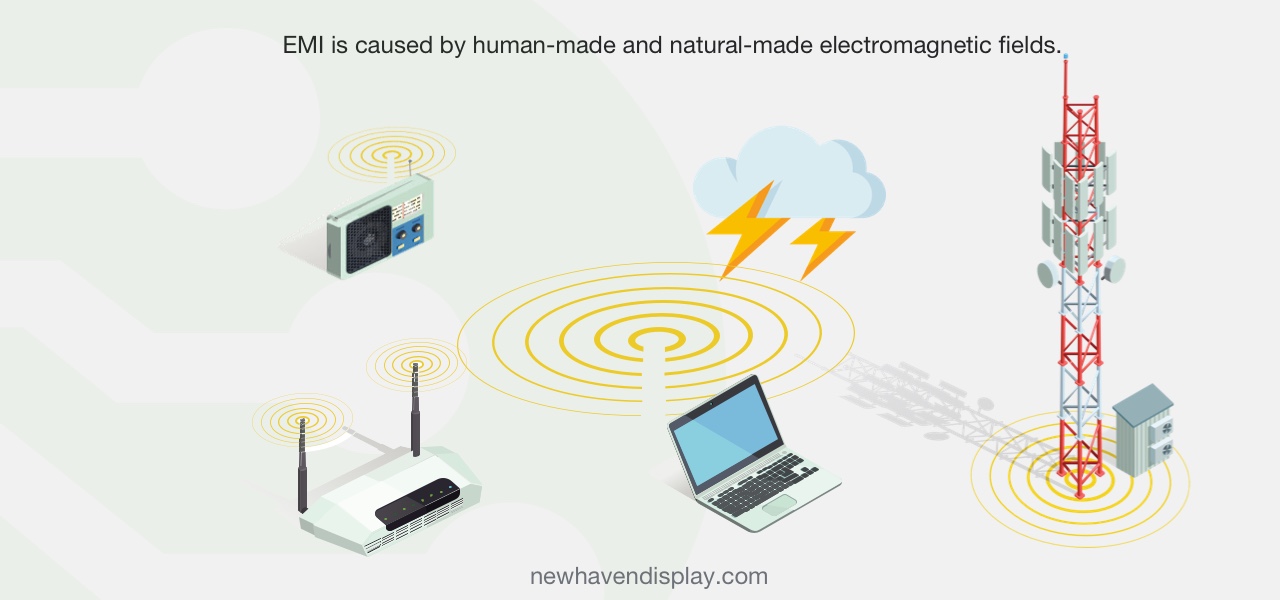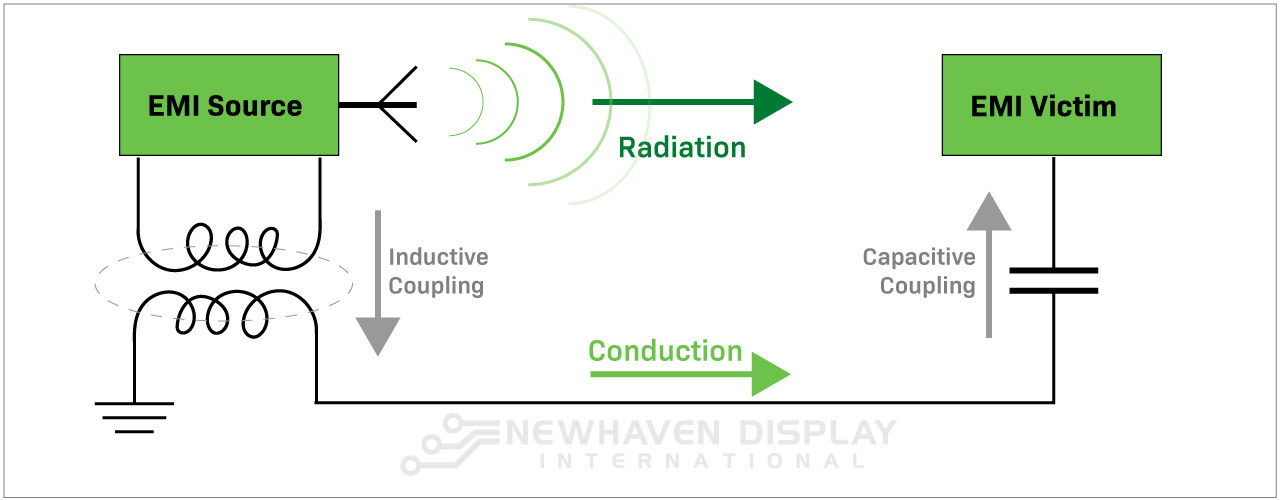EMI (Electromagnetic Interference)
Electromagnetic fields are everywhere. These invisible areas of force, consisting of magnetic and electric energy, can come from man-made or naturally generated sources.
Sometimes these electromagnetic fields can cause interference or disruption to another electrical or electronic device, causing a phenomenon called electromagnetic interference or EMI.
In this Article:
What is EMI (Electromagnetic Interference)?
EMI (Electromagnetic interference), also known as RFI (Radio Frequency Interference), is a disruption or interference that affects the operation of an electrical or electronic device.
What does EMI stand for?
EMI stands for electromagnetic interference.
This interference can cause electronic devices to operate poorly or stop them from working altogether. In some cases, this can lead to severe consequences, such as failures in medical devices, machinery, and military equipment.

What Causes EMI?
Electromagnetic interference is caused by electromagnetic fields developed from human-made electrical or electronic devices, natural sources, and events.
Whenever electronic signals meet at the same frequency, they disrupt one another, causing EMI.

Related: How to Protect Components against ESD (Electrostatic Discharge)
Examples Of EMI
Human-made EMI
Manufactured (human-made or man-made) electromagnetic interference is caused by everyday items in our homes (residential EMI) and also by equipment and devices used in the industrial sector (industrial EMI).
Residential EMI
The sources of Residential EMI would be all electronic devices and appliances in your home, especially anything operating with a wireless signal. These can disrupt other electronic devices in your home.

Fortunately, these sources of EMI do not usually cause significant damage. However, the EMI in our environment is becoming stronger as we use more and more electronic devices in our homes, and this can cause more disruption.
As manufacturers work to improve the performance of devices like cell phones, this can cause even more EMI.
Related: Whats an IPS Display?
Examples of residential man-made EMI:
- Laptops, computers, cell phones, and tablets
- Bluetooth and Wi-Fi devices
- Fluorescent and OLED light bulbs
- Microwave ovens
Industrial EMI
Industrial or commercial EMI causes more significant interference than residential EMI because it can reach broader areas and devices. Industrial EMI can affect hospitals, military operations, TV/radio stations, and other nearby equipment and devices.

Examples of industrial man-made EMI:
- Cellular towers and satellite communication networks
- High voltage electrical power lines
- Industrial electric motors and generators
- TV and radio broadcast transmitters
- Medical imaging systems, MRI, X-ray, and radiation therapy
Natural EMI
Natural electromagnetic interference (EMI) is caused by natural sources and events, including solar flares, lightning, and auroras. Natural EMI can sometimes happen without warning, causing severe interference to electronic devices that have not been appropriately protected.
Occasionally, EMI from the sun can affect satellite transmissions. For instance, if the sun is behind the satellite, the electromagnetic noise it creates could cover up the communication from the satellite.
Natural EMI usually has a more significant impact on older devices, while many modern devices hold up well to the effects caused by natural EMI as new technology emerges.

Examples of natural EMI:
- Thunderstorms, atmospheric electrical storms, and lightning
- The sun's solar flares and cosmic radiation
- Solar winds like aurora borealis known as the Northern Lights
- Static electricity
Types of electromagnetic interference
EMI can be categorized based on different characteristics, including transmission, duration, bandwidth, and source.
Transmission
EMI by transmission can be categorized into two main types:
- Conducted EMI
- Radiated EMI
Conducted EMI
In conducted electromagnetic interference, the sources of the EMI are in physical contact with one another. For instance, along power lines or a large motor. You might have seen an example of this when you have several items in your home using the same electrical circuit, and turning on one device causes another one to malfunction.
Radiated EMI
Radiated electromagnetic interference is the most commonly experienced form of EMI. This type comes from sources without direct contact with each other. The transmission is wireless and can travel through air, space, plastic, and insulators without needing an electrical connection.
Duration
Another way to categorize electromagnetic interference is by the duration or how long the inference lasts.
EMI by duration can be categorized into:
- Continuous
- Sporadic
Continuous EMI
When the source of EMI causes a prolonged signal, this is referred to as continuous interference. You would find this EMI with a steadily operating motor or an electronic circuit. Often these are low voltage, such as lighting and power sources in your home.
Sporadic EMI
Sporadic interference is also called impulse because the source only causes temporary interruptions. This would occur in the case of an electrical storm, solar flares, or an electrostatic discharge.
Bandwidth
We can even further divide EMI types into subcategories using their bandwidth. There are narrowband and broadband electromagnetic interferences.
Narrowband EMI
Narrowband is often caused by a radio transmitter or a form of oscillator. It only affects a single or a narrow band of frequencies. Although this type of inference doesn’t usually have a major effect on electronic equipment, it should be kept within acceptable limits.
Broadband EMI
Broadband affects large portions of the radio spectrum and at many different frequencies. It is often caused by malfunctioning equipment. Some of the sources of broadband EMI can be thermostats, voltage regulators, ignition systems, radar and communication transmitters, pulse generators, and personal computers.
Source
As explained earlier, EMI can be classified by the source type - natural and man-made EMI.
EMI by source can be categorized into:
- Human-made equipment and devices
- Natural sources and events
How is EMI transmitted?
There are different methods by which EMI is transmitted. The EMI coupling mechanism describes the path the EMI takes as it travels from the source to the receiver. In order to correct the problem the EMI is causing, it is essential to understand how it is getting to the receiver.
EMI transmission methods:
- Conduction
- Radiation
- Capacitive
- Inductive/Magnetic

EMI by Conduction
Conductors (wires and cables) connect the EMI source to the receiver. This is very commonly seen in electrical power lines.
EMI by radiation
EMI is emitted or radiated without a physical connection between the EMI source and the receiver - this is the most popular form of coupling.
Capacitive EMI
This happens with two connected devices. There is a variation in the voltage of the EMI source that capacitively transfers a charge to the receiver.
Inductive/Magnetic EMI
This uses the principle of electromagnetic induction to induce currents in the target due to varying magnetic fields between the source and the target.
How to Measure EMI?
EMI can be measured using a spectrum analyser, oscilloscope, or broadband RF field meter. These devices can detect and measure the strength and frequency of electromagnetic signals in a given environment. They can also be used to identify the source of the EMI and determine if it is within safe levels or if it is causing interference with other electronic equipment
Devices to detect or measure electromagnetic interference
- Spectrum Analyser
- Oscilloscope
- Broadband RF Field Meter

Spectrum Analyzer
These can measure the frequencies in a signal to determine if there is any interference. They can detect intentional and unintentional EMI. A spectrum analyzer measures signal amplitude vs frequency domain.
Oscilloscope
These are often used to identify EMI on high-voltage signals such as electric power lines. They measure signal amplitude vs time domain and are often used in addition to a spectrum analyzer.
Broadband RF Field Meter
This measures the amount of EMI in a certain area. It is one of the most common tools used to detect and measure EMI.
Protection from EMI
For electronic devices to coexist, they have to be able to operate without negatively affecting each other. There are several methods that can be used to reduce EMI produced by electronic components within a design.
One method implemented in many of our TFT and capacitive touchscreen designs to help reduce EMI is by including a polymer coated EMI shield layer, plus additional grounding that covers the connecting Flat ribbon cable.
Many of our character and LCD display modules offer a selection of grounding options that can be configured by jumper pads on the display’s PCB. Some options include connecting the front metal frame to DC ground or isolating it from electrical ground so it can be connected directly to chassis ground.
The same grounding options apply to the LCD display’s mounting holes. Solder pad jumpers can be configured to select chassis ground or DC electrical ground connections.
Please contact us at Newhaven if you wish to implement any of these options or other customized grounding solutions to meet your needs.
How to Reduce EMI?
Here are some additional design recommendations that can help reduce EMI noise within a new design.
- Shield the data and interface cables.
- Filter the power supply, data, and control lines.
Shield the data and interface cables
Use shielded cables, ferrite shields, or even copper tape to help reduce noise emissions or prevent noise transmissions.
Filter the power supply, data, and control lines
Adding small amounts of series resistance to the data and control lines will also help reduce noise transmissions. Adding filter capacitors to power supply lines is also good design practice.
Placing filtering components such as resistors, capacitors, inductors, or ferrites closer to the source of the noise will yield better and more effective results.
Consider using regulator circuits to produce the desired output voltage as these typically have lower EMI noise than using switching supplies or DC-DC converters.
If a product design consists of additional components like a front bezel, mounting bracket, EMI mesh, ITO shield, etc. then ensure these components are connected via a short path to ground.
Related: OLEDs Vs LCDs
All About EMI - [Video]
Our Applications Engineers are available to answer your questions and help provide options and solutions to reduce EMI with your display project.
Latest Blog Posts
-
A Guide to TFT Display Interfaces
Display interfaces often get less attention than screen resolution or brightness, but they carry jus …Dec 16th 2025 -
Choosing the Right Display Resolution: A User-Friendly Guide
Display resolution is one of the most defining choices in product interface design. It determines ho …Dec 11th 2025 -
Arduino vs Raspberry Pi vs BeagleBone: Key Features and Differences
If you're working on an electronics project—whether it's for a DIY automated device, a digital sign, …Dec 8th 2025





